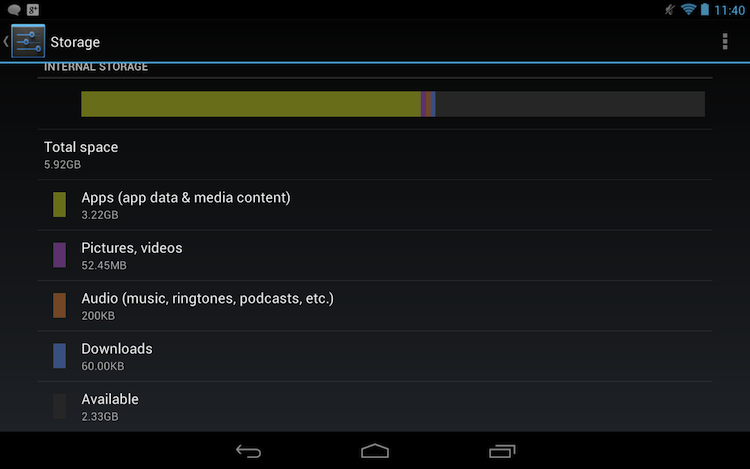
Storage space on your smartphone, or lack thereof rather, isn't something many people lose sleep over at night. Unlike a computer or an external HDD, most people don't plan on storing their entire music and digital movie libraries on their pocket-sized computer, and thus aren't too worried about how much storage space their phone has. The typical 8GB or 16GB of built-in storage with supplementary removable storage (microSD cards) will usually suffice.
Of course, there are always those individuals who like to hoard things (pictures, movies, music, apps, etc.) who need the additional space and are quickly learning that with high definition displays and optimized content – HD movies, HD apps and games and the like – can eat through storage space faster than anything.
We learned this the hard way once Apple fitted their newest installment of the iPad with a Retina Display, a resolution of 2048 by 1536 pixels – that's over three million glorious, color-filled pixels. And it comes with only one consequence: better graphics that take up more storage space. How much more, exactly? Vietnamese site Tinhte found that iOS applications that have been updated to support the Retina Display on the new iPad would be up to five times larger.
And so the repercussions of the HD movement have begun …
When I pre-ordered the Nexus 7 from the Play Store during the Google I/O 2012 opening keynote, I had a short internal debate over which capacity I should go with. "8GB or 16GB? $199 or $249?"
I figured I would play with it for some time and that it would eventually start collecting dust. It still may; I'm only just over two weeks in. But it has quickly (and unexpectedly) become my go-to device for mobile gaming and entertainment, the tablet that hardly leaves my side. And now that I've installed just a couple of my favorite games, I'm learning that 16GB might have been the more appropriate choice.

Out of the box, only 5.92GB of the total 8GB are available. I currently have 2.33GB free and have only installed a handful of applications and a few of my favorite games. Applications alone are taking up 3.22GB while pictures take up 52.45MB, audio takes up 200KB and downloads take up 60KB. Not to mention, I've only installed some games without downloading the necessary resources packet (usually between 250MB and 1GB) to make them work.
I also ran into a similar issue on the new iPad. I chose the 16GB variant to save $100. When trying to upgrade to the latest iOS 6 beta last week, I had to go through and free up memory just so the install would complete. The update required 1.9GB of free space and I had less than 1GB available. Almost all of the space was taken up by games and apps – there was no music or movies and hardly any pictures.
Truthfully, though, this isn't a problem that anyone should have to deal with. Manufacturers are looking to cut costs in any way possible, I get that. But flash memory is dirt cheap in comparison to what it was just a few years ago, yet they've shaving pennies off the top-end of cost by copping out on internal storage and not including a microSD card slot. Built-in flash storage on devices has hardly increased at all while the required storage for high definition graphics is vastly more demanding.
Running out of storage space is never something I have had to deal with on a smartphone before. But now that almost all of my devices (HTC One X, Samsung Galaxy Nexus, iPhone 4S, new iPad, Nexus 7) have limited storage and no option for expandable memory, the side-effects are finally starting to kick in. I've had to delete applications, games and other files on almost all of my devices of late.
My question now is: do you pay the extra cash for a device model with more storage capacity?
I have taken the cheap route every time for the last five or six devices I have purchased (if capacity options were available), and I'm beginning to regret ever doing so.
Earlier this week, Samsung confirmed its 64GB variant of the Galaxy S III is still in the works, shooting down rumors that the larger model had been canceled due to low demand. Don't get me wrong, I'm glad Samsung is making a phone with 64GB of memory, but 64GB should be the middle tier, not the upper-end model. In fact, moving forward, no phone or tablet should launch with anything less than 32GB of built-in storage.
(Note: Part of the problem with larger flash storage is the stability. Lower capacities are more stable and crash less. I understand that. But the days of 8GB and 16GB storage options in high-end phones should be long gone.)
Alas, this isn't a perfect world and it's going to take more than the whiny rant of a writer to make manufacturers build phones with more storage space.
Tell me, readers. Do you opt for as much storage space as possible? Or do you go with what fits the budget better? Are you holding out for a 64GB Galaxy S III, hoping that a U.S. carrier will pick it up?